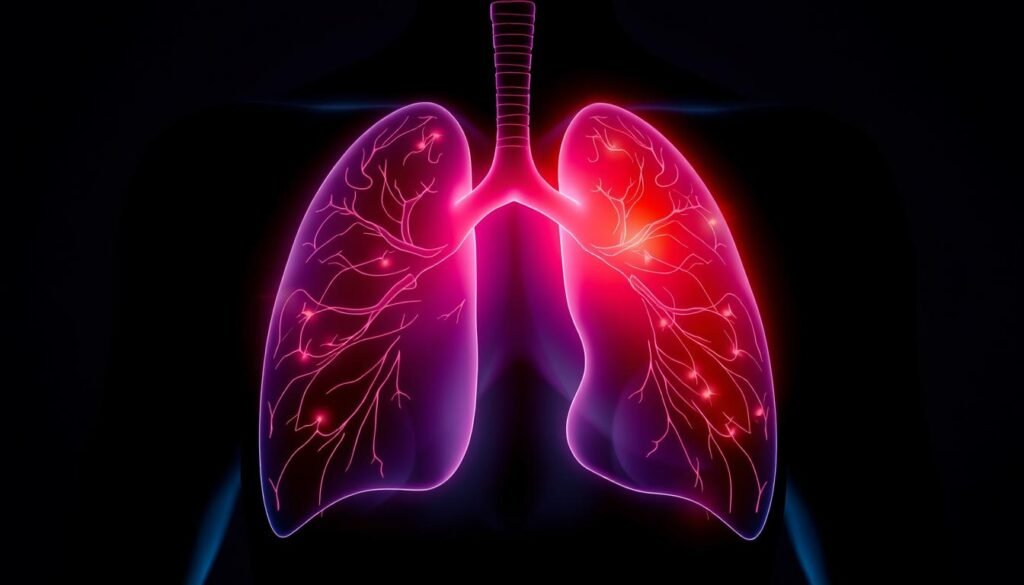Did you know that around 80% of people with finger clubbing are linked to lung cancer? This symptom is important for catching lung cancer early, which can help treat it better. The finger test, also known as the Schamroth window test, helps identify finger clubbing. It can point to low oxygen levels, which are often seen in serious conditions like lung cancer. Knowing about the finger test is crucial. It helps people seek help early.
Finger clubbing is a key signal, but it usually doesn’t show up at lung cancer’s start. Still, knowing about this and other signs is vital for lung cancer early detection. Being informed allows people to find lung cancer before it gets worse. This approach boosts their chance of effective treatment.
For more information on how nails can signal early cancer, check this resource.
Key Takeaways
- Around 80% of individuals with finger clubbing may have lung cancer.
- Finger clubbing often appears in advanced stages, not during early lung cancer.
- Early detection of lung cancer can significantly lower mortality rates.
- The finger test is a quick and simple assessment method.
- Annual low-dose CT scans are recommended for high-risk individuals.
- Prognosis improves dramatically with early diagnosis.
- Being proactive can enhance treatment outcomes and recovery chances.
Understanding the Significance of Early Detection in Lung Cancer
Finding lung cancer early is key to better outcomes for patients. In the U.S., it is the second most common cancer, with about 238,340 new cases in 2023. Spotting lung cancer symptoms early can greatly increase survival chances. Symptoms like ongoing cough, feeling very tired, and shortness of breath should prompt quick action by doctors.
Most lung cancer is found late, when treatments aren’t as effective. Therefore, lung cancer screening is crucial, especially for those at higher risk. This includes smokers or those exposed to radon gas and asbestos. The United States Preventive Services Task Force suggests yearly low-dose scans for people who have a 20 pack-year smoking history. Yet, few eligible people get these recommended screenings.
Early recognition of signs and getting the right lung cancer diagnosis is essential for early treatment. Imaging tests and biopsies are crucial in confirming the presence and type of lung cancer. They help start the right treatment quickly. Early detection improves treatment options and significantly boosts the chance of recovery. It is a vital part of combating this widespread disease.
What Is the Finger Test for Lung Cancer?
The finger test for lung cancer is called the Schamroth window test. It’s an easy way for people to check for signs of finger clubbing. Finger clubbing could mean serious health issues, like lung cancer.
Overview of the Finger Test
The Schamroth window test is used to find finger clubbing, seen in many lung cancer patients. To do the test, press the nails of two opposite fingers together. If you see a diamond-shaped gap, that’s normal. If not, it could mean finger clubbing, asking for more checks.
How the Test is Performed
Doing the Schamroth window test is quick and simple. Here’s how:
- Pick one finger from each hand.
- Touch their nails together firmly.
- Look for a small diamond-shaped space between the nails.
- No gap could suggest finger clubbing.
This easy test can help spot early signs of lung cancer. It shows how important it is to pay attention to our health. For more on lung cancer and treatments, visit this resource.
| Condition | Percentage of Lung Cancer Patients |
|---|---|
| Finger Clubbing | Up to 35% |
| Non-Small Cell Lung Cancer | Over 35% |
| Small Cell Lung Cancer | 4% |
Knowing about these tests could lead to catching diseases early. This can make a big difference. Always talk with a doctor for a proper check-up.
What is Finger Clubbing?
Finger clubbing is a condition that affects fingers and sometimes toes. It makes changes in the nails and fingertips visible. Recognizing these changes is crucial as they could signal serious health problems, including lung cancer.
Symptoms and Appearance
Symptoms of finger clubbing include enlarged fingertips and nails that look different. You might notice:
- Softening of the nail beds
- Curved nails that point down towards the fingertips
- Bulging, swollen tips of fingers or toes
- Nails that may seem red or darker than normal
This condition often affects both hands and usually develops slowly. But sometimes, it can appear quickly if lung problems are severe.
The Connection Between Finger Clubbing and Lung Cancer
There’s a strong link between finger clubbing and lung cancer. About 5% to 15% of people with lung cancer experience it. It’s often seen with non-small cell lung cancer (NSCLC). Scientists believe that a rise in Vascular Endothelial Growth Factor (VEGF) levels triggers clubbing.
Doctors have ways to check for finger clubbing. They look at the Lovibond angle and use the Schamroth sign. These tests help see how severe the clubbing is. People noticing these symptoms should see a doctor right away. It could point to lung cancer.
Common Symptoms of Lung Cancer
Spotting lung cancer symptoms early is key to getting quick treatment. Many symptoms can hint at lung cancer. Knowing them helps people get help sooner.
Identifying Early Symptoms
Here are some early signs of lung cancer:
- A persistent cough lasting three weeks or more.
- Unexplained fatigue.
- Shortness of breath during regular activities.
At first glance, these early signs might not worry you. Yet, they could be clues to lung cancer. If you notice them, it’s important to see a doctor quickly.
Advanced Symptoms to Watch For
Later stages of lung cancer bring more severe symptoms. They greatly affect how a person feels day-to-day. Let’s look at these:
- Chest pain that gets worse with deep breaths or coughs.
- Spitting up blood or seeing rust-colored spit.
- Wheezing or a long-lasting hoarse voice.
It’s vital to understand these common symptoms of lung cancer. They can be easy to ignore. Noticing them early can lead to faster diagnosis and treatment.

Lung Cancer Diagnosis and Screening Methods
Lung cancer diagnosis uses many methods to pinpoint and stage the disease. It helps patients and doctors choose the best treatment options.
Role of Imaging Tests in Diagnosis
Imaging tests are key in finding lung cancer by showing pictures of the lungs. The main tests include:
- Low Dose Computed Tomography (LDCT): Very effective for finding lung cancer early, especially for those at high risk.
- Chest X-rays: Can show areas that might need a closer look.
- Magnetic Resonance Imaging (MRI): Checks if cancer has spread to the brain or soft tissues.
- Positron Emission Tomography (PET): Often used with CT scans to determine the cancer stage.
- Bone Scans: Shows if cancer has moved to the bones.
These methods give insights into the tumor’s size, place, and spread. This info is crucial for diagnosing lung cancer and planning treatment.
Importance of Biopsies
Biopsies are essential to prove cancer is present. There are different kinds, each serving a unique purpose:
- Fine Needle Aspiration (FNA): A simpler way to collect tissue samples.
- Core Biopsy: Gives larger samples for a detailed look at lung tissues.
- Bronchoscopy: Lets doctors see and take samples from tumors in the airways.
- Endobronchial Ultrasound: Helps check lymph nodes near the lungs.
Biopsies and imaging tests together can spot lung cancer early. This makes treatment more likely to work. It shows why regular checks are vital for those at higher risk.
Importance of Timely Medical Consultation
Getting help early for lung cancer symptoms can greatly affect treatment. If you notice persistent coughs or unexplained weight loss, see a doctor. Studies show people waited on average 8 weeks to get help, with delays up to 336 days. This delay happened in 52% of cases, showing why early importance of medical consultation matters.
When to Seek Medical Help
Knowing lung cancer symptoms and getting timely help is crucial. From first seeing a doctor to getting a specialist referral took about 5 weeks. Nearly half of patients saw delays in referrals. This can miss the chance for an early diagnosis. It’s key to talk to doctors early about any symptoms.
The Role of General Practitioners
General practitioners play a key role in diagnosing lung cancer. Often, multiple visits are needed before a diagnosis. About 30% see their doctor three or more times. This shows how important it is to talk to healthcare providers early. Many patients have several consultations before getting diagnosed. Talking to a GP can help you get necessary tests sooner. It also helps with a quick lung cancer diagnosis. Using resources like the importance of medical consultation increases awareness and urgency to seek help.

Understanding Paraneoplastic Syndromes
Paraneoplastic syndromes are a group of disorders sparked by cancer, including lung cancer. These conditions happen when tumors make hormones or other substances. This leads to symptoms not directly caused by the cancer itself. Spotting paraneoplastic syndromes, especially in lung cancer patients, is crucial. It affects both treatment and how the patient might do in the future.
Connection to Lung Cancer
About 10% of people with lung cancer have paraneoplastic syndrome. They often show high levels of certain hormones and have metabolic issues, like too much calcium in their blood. At diagnosis, 2% to 6% of lung cancer patients have high calcium levels. This number can go up to 8% to 12% as the cancer gets worse.
This problem is very common in squamous cell carcinoma. Here, up to 23% of patients might have it.
Other Symptoms Linked to Paraneoplastic Syndromes
The symptoms from paraneoplastic syndrome in those with lung cancer can be quite different. High calcium can affect the circulatory and digestive systems, as well as the brain and mood. This can lead to serious health issues. Another condition to note is the Syndrome of Inappropriate Antidiuretic Hormone Secretion (SIADH). It’s seen in 1% to 2% of all cancer patients.
In those with small cell lung cancer, SIADH appears in 10% to 45% of cases. This shows a strong connection to lung cancer symptoms.
Possible Causes of Finger Clubbing
Finger clubbing often points to serious health issues, especially chronic ones. Lung cancer is a major cause, but there are many other conditions too. Knowing these causes helps people get treatment early, which can improve their health.
Chronic Conditions Linked to Clubbing
Many chronic illnesses can lead to finger clubbing. It’s crucial to take this sign seriously. Some key conditions include:
- Lung cancer, causing about 80% of clubbing cases.
- Interstitial lung diseases such as pulmonary fibrosis and cystic fibrosis.
- Heart issues like cyanotic congenital heart disease and subacute bacterial endocarditis.
- Liver problems, including cirrhosis.
- Gastrointestinal issues, like celiac disease and inflammatory bowel disease.
- Genetic factors leading to primary clubbing, which happens without other health problems.
Knowing about these conditions can increase awareness. It encourages people to seek medical advice early.
Inferring the Underlying Causes
Figuring out the causes of finger clubbing requires thorough evaluation. Doctors review medical history and symptoms. They use exams and tools like X-rays and CT scans for diagnosis. Treating the main health issues might help reverse clubbing. For more details, check out this resource. It gives deeper insights into treatments and how clubbing relates to severe health problems.

Treatment and Management for Lung Cancer
Lung cancer treatment uses various methods depending on the disease type and stage. Options include surgery, chemotherapy, radiation therapy, and targeted therapies. Recent advances like immunotherapy have been promising. Lifestyle changes also play a vital role in recovery and health improvement.
Common Treatments Available
Those with lung cancer have many treatment choices tailored to their situation. These options are:
- Surgery: Removes tumors, best in early stages.
- Chemotherapy: Uses drugs to kill or halt cancer cells.
- Radiation Therapy: Uses high-energy rays to destroy cancer cells.
- Targeted Therapies: Targets specific molecular aspects of cancer.
- Immunotherapy: Boosts the body’s immune fight against cancer.
Importance of Lifestyle Changes
Healthier habits greatly affect well-being and recovery after lung cancer treatment. Important lifestyle changes are:
- Quitting Smoking: Critical for lung health, stops more damage.
- A Balanced Diet: Nutrient-rich foods boost the immune system.
- Regular Exercise: Keeps strength and vitality up.
- Stress Management: Mindfulness or therapy aids emotional health.
Adopting these habits is key in a lung cancer treatment plan. To learn more about lung cancer treatments, visit the AHN Lung and Pleural Cancer Center.
Nail Changes Associated with Cancer
Nail changes can be key clues to underlying health problems, like cancer. Things like discolored, thin, or brittle nails can be warning signs. Particularly, lung cancer might show signs through the nails. For example, if nails look rounded and the beds feel soft, it might be early lung cancer.
How Nail Changes Can Signal Underlying Issues
It’s crucial to watch for nail changes if you’re dealing with cancer. In advanced lung cancer, nails might curve more or bones could grow near joints. These changes often come with swelling or skin discoloration near the nails. These symptoms could also be from Pancoast tumors, causing arm pain and making you uncomfortable.
Other Related Skin Symptoms to Monitor
It’s also important to watch for skin symptoms with these nail changes. Look for rashes, lesions, or swelling in the face and neck because these can mean poor blood flow. Also, being very thirsty or losing weight without trying could signal cancer’s impact. Paying attention to these signs can help you seek medical help sooner, which can lead to better treatment outcomes.